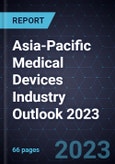Disruptive Technology Adoption and Transformative Mega Trends Pave the Way for Innovations
While the United States and Europe medical device markets face backlash from the economic slowdown, the Russia-Ukraine war, and the cost-of-living crisis, the APAC medical devices market continues to record phenomenal growth. However, 2023 will be challenging for APAC Medtech due to uncertainties arising from the anticipated market slowdown and other macroeconomic factors. Bank failures in the United States also continue to create ripple effects in APAC, with Credit Suisse being the latest.
In this study, the publisher analyzes the APAC medical devices market, including macroeconomic factors, the latest trends, revenue forecasts, and predictions. The study period is 2022-2027 and the forecast period is 2023-2027, with 2022 as the base year. We also provide country-specific analyses for China, India, Japan, South Korea, and the rest of APAC. Medical device segments covered include orthopedics, cardiology, respiratory, diabetes, wound care, and others. The study excludes the refurbished medical devices market in APAC.
Our analysis shows that a long-term change that will impact the industry is sustainability. Although lagging in sustainability efforts compared to global counterparts, medtech players in APAC are getting back on track to achieve 2030 Sustainable Development Goals, some even aiming for 2025 or 2027 to achieve carbon neutrality.
The digitalization of medical devices will continue, with original equipment manufacturers digitalizing their devices and operations. This also pushes Medtech participants to deliver value for providers and patients with devices and digital data, leading to new business models and disruptive technologies.
As APAC transitions conventional approaches to healthcare innovation, it involves an extensive coalition of healthcare stakeholders. This enables the exploration of new methods that combine diagnostics, devices, digital tools, emerging technologies, and medication to deliver improved patient outcomes.
The publisher offers stakeholders insights into opportunities that arise from the increased inclusiveness of underserved patient populations, robotics adoption, and the transition of care from hospitals to home-based models.








